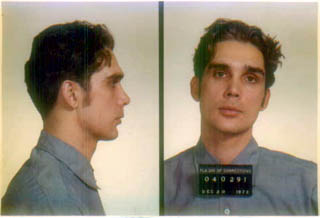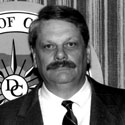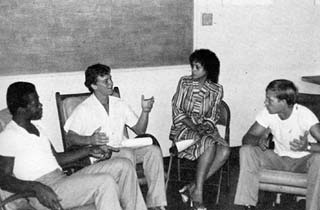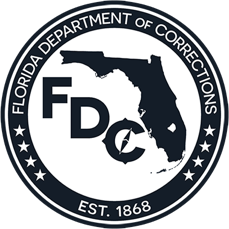1979
INMATE POPULATION JUNE 30, 1979: 19,995
On September 1, 1979, the Department's Probation and Parole Services is restructured to follow judicial circuit boundaries, creating 20 Probation and Parole Circuit Offices. This reorganization streamlines management by eliminating one tier of supervision, establishes Senior Probation and Parole Officer positions as specialists to concentrate on the supervision of youthful offenders, and provides a career ladder for professional staff. The new structure is designed to improve accountability, service delivery, and staff morale.
April, 1979 - Florida Department of Corrections signs a contract with the Commission on Accreditation for Corrections to begin the process of gaining accreditation for all 24 of its major institutions. Florida becomes the first state to enter all of its facilities into the accreditation process.
The department's computer system moves from Florida State University to the new Justice Data Center, a mainframe computer system created by the legislature in 1978 and operated by the Judicial Branch located in Tallahassee. The department's database is growing quickly into a viable computer system that will serve the multi-faceted needs of FDC staff. It is named "Offender Based Information System (OBIS)" but more commonly called "MIS" (Management Information System) by staff. The OBIS system has grown to include external movement, sentence structure, disciplinary reports and gaintime.
Hendry Correctional Institution (Immokalee, FL) and Lancaster Correctional Institution (Trenton, FL) open. Hendry CI closes on July 1, 2002 and reopens on December 19, 2002.

John Spenkelink
On May 25, 1979, John Spenkelink becomes the first inmate to be executed in Florida following the resumption of capital punishment.
His execution is controversial for several reasons. David Brierton, the superintendent at FSP, chooses to have Spenkelink already seated in the chair when the blinds are opened for the witnesses to see him. He says his purpose is to keep secret the identity of those strapping Spenkelink into the electric chair and to prevent Spenkelink the embarrassment of having people watch him being strapped in. Adhering to the "no good deed goes unpunished" rule, it is instead seen as an attempt to hide something.
RESUMPTION OF CAPITAL PUNISHMENT
Former Secretary Richard Dugger was there that day, as he was the Assistant Superintendent at Florida State Prison at that time:
"Spenkelink was a big test case for the resumption of capital punishment in Florida. He and his supporters never really thought he would be executed. Supt. Brierton attempted to "sanitize" the process by adding the blinds and having the inmate seated in the chair and strapped in before opening the blinds. That did not work well since the witnesses could see around the edges of the blinds (those on the front row) and the shock value of opening the blinds with the strapped-in condemned practically sitting in the laps of those in the front row was quite remarkable. Anti-death penalty supporters rallied hard to fight the execution up to the final minute and it was a circus for several weeks."
Wild rumors circulated that Spenkelink fought to prevent his execution, was gagged, his mouth taped and cotton inserted into his rectum before being placed in the electric chair. Other complaints included allegations of verbal abuse prior to the execution; inadequate phone communication between the prison and Governor's office; degrading full body searches of his mother and other relatives -- all of which are proved unfounded in an independent investigation by Inspector General Dick Williams and Attorney Irwin Block, at the request of Governor Bob Graham. (Miami attorney Block publicly opposed the death penalty.)
Since this was the first execution in Florida in more than 15 years (the last being Sie Dawson on May 12, 1964), there are naturally some procedural problems with the execution process. The problem areas are corrected for subsequent executions by being written into or clarified in the FDC Rules. Some of these areas include access to the media by the condemned; adequate contact visits of the condemned by immediate family; the right of the inmate to make a final statement; and clarifying the procedure for inventorying personal property.

Richard Dugger, who served as Secretary of the Department of Corrections from 1987-1991, selected David Brierton (pictured) to be his Deputy Secretary in 1988.
Then FSP Asst. Supt. Dugger, who dealt with the inventorying issue, among others, found himself on the receiving end of a questionable reprimand.
"I received a reprimand for losing Spenkelink's address book, though that's not what happened. Spenkelink wanted it on death watch and Supt. Brierton would not let him have it for fear of some contraband or coded message hidden therein. I persuaded Supt. Brierton to let me photocopy the information contained therein (names and addresses) and I did, but Spenkelink refused to accept that. After the execution I discarded the address book and the death penalty opponents tried to say it was some kind of cover-up."
An autopsy is not performed on Spenkelink, though the county (not the state) is required to do so by Florida statute. (This decision appears to be a financial issue rather than a sinister one.) Today, all inmates who die by execution have autopsies.
Regarding the final outcome of the independent investigation into Spenkelink's execution, Dugger had this to say.
"The conclusion was 'either the abuse did not happen or there was a conspiracy of silence' from those investigated (everyone at the prison). Apparently, they could not bring themselves to say that the complaints and allegations were unfounded."
 Click here to listen to Secretary Dugger discuss how he came to have a "last drink" with two death row inmates while he was an Assistant Warden.
Click here to listen to Secretary Dugger discuss how he came to have a "last drink" with two death row inmates while he was an Assistant Warden.

Correctional training institute in the 1970s

Inmates work in the Horticultural Program at Broward Correctional Institution.

Group counseling at Lantana Correctional Institution

Inmates perform construction work at Polk Correctional Institution.

Instructor supervises inmates in a Vocational Education electronics class.
- 1821-1845
- 1868-1876
- 1877-1895
- 1900-1919
- 1921
- 1922-1924
- 1927
- 1928-1931
- 1932 | CHAPMAN
- 1933-1935
- 1936-1939
- 1940-1945
- 1946-1949
- 1950-1955
- 1956-1961
- 1962 | WAINWRIGHT
- 1963-1965
- 1966-1969
- 1970-1975
- 1976-1979
- 1980-1986
- 1987 | DUGGER
- 1988-1990
- 1991 | SINGLETARY
- 1992-1995
- 1996-1998
- 1999 | MOORE
- 2000-2002
- 2003 | CROSBY
- 2004-2005
- 2006 | MCDONOUGH
- 2007
- 2008 | MCNEIL
- 2009-2010
- 2011 | BUSS
- 2011 | TUCKER
- 2012 | CREWS
- 2013-2014
- 2014 | JONES
- 2015-2018
- 2019 | INCH
- 2020-2021
- 2021 | DIXON
- 2022-Today
- Population Summary Table

